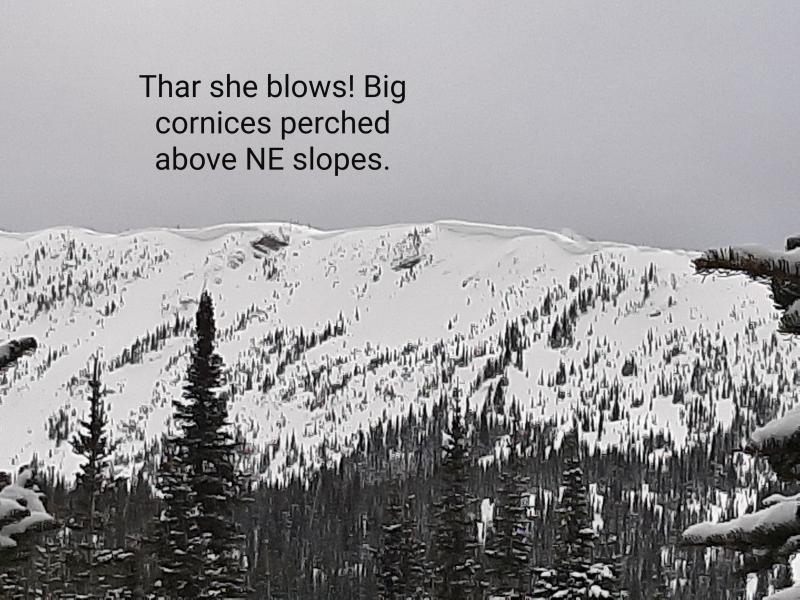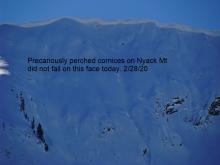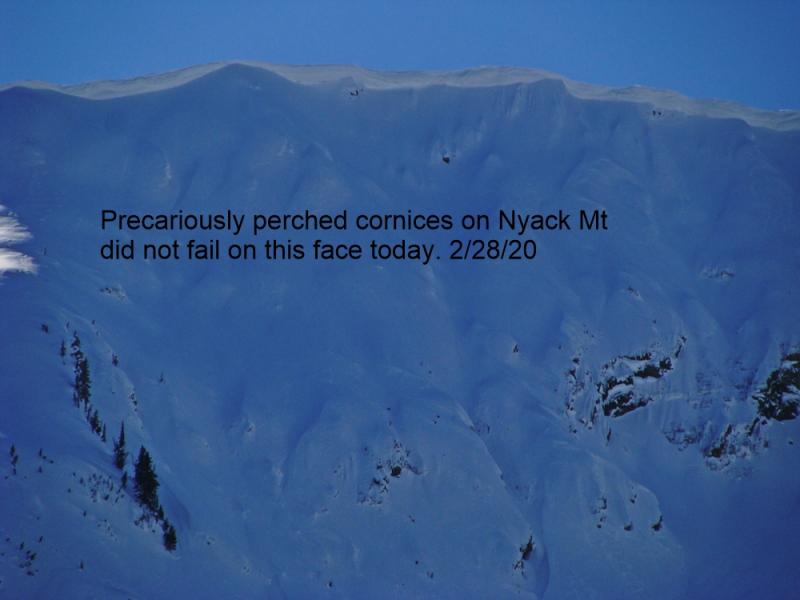| Tuesday | Tuesday Night | Wednesday | |
|---|---|---|---|
| Cloud Cover: | Windy with light snow showers | Windy conditions continue | Warming and dry |
| Temperatures: | 35-47 deg. F. | 21-29 deg. F. | 41-54 deg. F. |
| Wind Direction: | NE | E-NE | N |
| Wind Speed: | 22 gusts 41-45 | 12-14 gusts 37 | 5-7 gusts 20 |
| Snowfall: | 0-1 in. | 0 in. | 0 in. |
| Snow Line: |
Whitefish Range
Swan Range
Flathead Range and Glacier National Park
How to read the forecast
We have a somewhat complex wind slab problem today. Recent snow, combined with north-northeast winds, will create fresh wind slabs on atypical slopes. In many locations these wind slabs will form on a sun crust and/or low density snow. Lingering instabilities in wind slabs formed over the past few days will be found on typical leeward aspects. The avalanche danger is MODERATE. Carefully assess terrain for recently formed windslabs along ridgelines and cross-loaded features before committing to a slope.

2. Moderate
?
Above 6500 ft.
2. Moderate
?
5000-6500 ft.
1. Low
?
3500-5000 ft.
- 1. Low
- 2. Moderate
- 3. Considerable
- 4. High
- 5. Extreme
-
Type ?
-
Aspect/Elevation ?

-
Likelihood ?CertainVery LikelyLikelyPossible
 Unlikely
Unlikely -
Size ?HistoricVery LargeLargeSmall

At upper elevations there is an abundance of relatively light and dry surface snow on shaded aspects. Late last night winds shifted to the north-northeast and will continue through the day. These winds will will easily move this snow around and we should expect atypical loading patterns as normally scoured slopes will become wind loaded as the day progresses. In many areas these fresh wind slabs will be depostited onto a sun crust or onto a thin layer of low density snow which is sitting atop this crust. Yesterday, we noticed that the new snow capping the sun crust was not bonding well to that crust. This crust will make for a slippery bed surface and a great sliding layer for these slabs to slide on.
Over the past few days winds have blown out of the southwest and have formed wind slabs on northwest through southeast aspects. Be aware that there may be lingering instabilities within some of these features today.
Our wind slab problem today is more complex than normal with all aspects being recently loaded by new snow and wind. Avoid steep, exposed windloaded slopes today. Pay attention to obvious signs of instability like recent avalanches and cracks shooting out from your skis or machine.
-
Type ?
-
Aspect/Elevation ?

-
Likelihood ?CertainVery LikelyLikelyPossible
 Unlikely
Unlikely -
Size ?HistoricVery LargeLargeSmall

Very large cornices continue to grow across the advisory area. Heat and sun can cause these to fail, but the additional load brought by wind and snow can also tip the scale. Cornices can pull out from surprising distances behind the ridgeline. Keep a good buffer between you and cornices while traveling above them, and minimize your exposure time when traveling below. Remember that cornice fall can also awaken deeper instabilities in the snowpack, and trigger much larger avalanches like wind slabs or weak snow near the late Feb. or March crusts.
Additional concern: If you are recreating in Glacier Park today be heads up! Substantial snow has fallen overnight in the northern and eastern portions of Glacier. These areas are outside our forecast area and we do not forecast for these locations. Expect to find reactive storm slabs in this new snow today. We recommend that you stick to low angle slopes and avoid being in and under avalanche terrain today.
As we continue into spring and day-time temperatures approach the freezing mark conditions can change rapidly. Short periods of sunshine can weaken the snow surface and result in loose, wet avalanches. Pay attention to the signs of increasing instability like roller balls forming on steep slopes or a moist snow surface. These are indications that it is time to move to shaded or less steep slopes. Also, we have observed glide cracks starting to open in many locations and several have even failed (image). Given the unpredictable nature of glide avalanches it is best to avoid slopes where they are present.
Weak snow surrounds a series of crusts 1.5 to 3 feet from the surface, but has not produced recent avalanches. However, digging into the snow and performing stability tests is the only way to determine if this weak layer exists. Stability tests in some locations last week show these layers can fracture and propagate (video1, video2).
Monday: My partner and I travelled to Skookoleel Ridge in the southern Whitefish Range where we found 4 inches of new snow deposited on top of a sun crust on sunny aspects and on top of older snow or a melt freeze crust on shaded aspects. The new snow was low density and cohesionless even where it had been affected by wind (observation).
Sunday: Skiers in the Skiumah/Great Bear Drainages in the Flathead Range noted increasing winds as the cold front moved into the area yesterday that was actively drifting the recent snow. They triggered a small pocket of windslab from the ridge, and wisely altered their plan due to new wind slab formation (observation).
Saturday: Skiers in Noisy Basin in the Swan Range reported four skier triggered avalanches on steep, north-northeast facing slopes. The avalanches were up to a foot deep and triggered within recent storm snow. Luckily, no one was caught in these slides (observation). Mark and Guy were in the Red Meadow area in the northern Whitefish Range. They found up to 18 inches of recent snow. They noted ongoing cornice formation, large glide cracks opening, and active wind drifting (observation). Skiers on Snowshed Mountain in the Flathead Range noted new cornice build-up in the area. They also found lingering instability in recent windslabs almost 2 feet from the surface that were on top of a layer of weak, faceted snow (observation).
Friday: Erich and I rode into the Lost Johnny drainage in the Swan Range. We found 14-22 inches of recent snow on top of a crust. We observed fresh windslabs formed on the leeward sides of ridges, and moderate winds continued to drift the recent snow (observation).
Thursday: Erich toured along the Marion Lake/Dickey Creek ridgeline yesterday in the Flathead Range. They observed shooting cracks on most wind loaded terrain and triggered a 100 ft. wide and 10-14 inch deep wind slab on a northeast aspect (image and video). Strong winds were loading multiple aspects (observation). Deeper weak layers around a series of crusts were unreactive in our stability tests at this location.
Visit our Observations page and our You Tube channel for more observations from the entire season.
Thanks to everyone for submitting observations. They are extremely useful and could help save lives.
HOW TO SUBMIT OBSERVATIONS:
Email: [email protected]
Call and leave a message: 406.387.3821
You can also submit quick observations via text: 406.241.4571 (FAC mobile)
OR
Submit Snowpack Observations: http://www.flatheadavalanche.org/node/add/snowobs
Submit Avalanche Observations: http://www.flatheadavalanche.org/node/add/avyobs
In the past 24 hours the advisory area saw light to moderate snow with accumulations up to 3 inches. Late last night winds shifted to the the north-northeast with upslope, or wrap around moisture, affecting select locations. This moisture was definitely hit or miss as evidenced by the Flattop Snotel in central Glacier Park, outside of our advisory area, reporting 20 inches of new snow and 1.5 inches of SWE while locations in John F. Stevens Canyon and the Marias Pass area reporting just a couple inches of snow. Expect a few lingering showers along the Continental Divide today but mostly dry conditions elsewhere. Light to moderate winds with strong gusts will continue to blow out of the north-northeast. Currently, temperatures above 6000 feet range from 23º-31º F, and winds are out of the north-northeast at 3-10 mph with gusts from 8-29 mph. Windy conditions will continue tonight with tomorrow being dry and warmer.
If you are recreating in Glacier Park today be heads up! Substantial snow has fallen overnight in the northern and eastern portions of Glacier. These areas are outside our forecast area and we do not forecast for these locations. Expect to find sensitive reactive storm slabs in this new snow today. We recommend that you stick to low angle slopes and avoid being in and under avalanche terrain.
| 0600 temperature: | 23-31 deg. F. |
| Max. temperature in the last 24 hours: | 28-34 deg. F. |
| Average wind direction during the last 24 hours: | SW |
| Average wind speed during the last 24 hours: | 5-15 mph |
| Maximum wind gust in the last 24 hours: | 13-29 mph |
| New snowfall in the last 24 hours: | 0-3 inches |
| Total snow depth: | 87-117 inches |
This advisory applies only to backcountry areas outside established ski area boundaries. This advisory describes general avalanche conditions and local variations always occur. This advisory expires at midnight on the posted day unless otherwise noted. The information in this advisory is provided by the USDA Forest Service who is solely responsible for its content.































